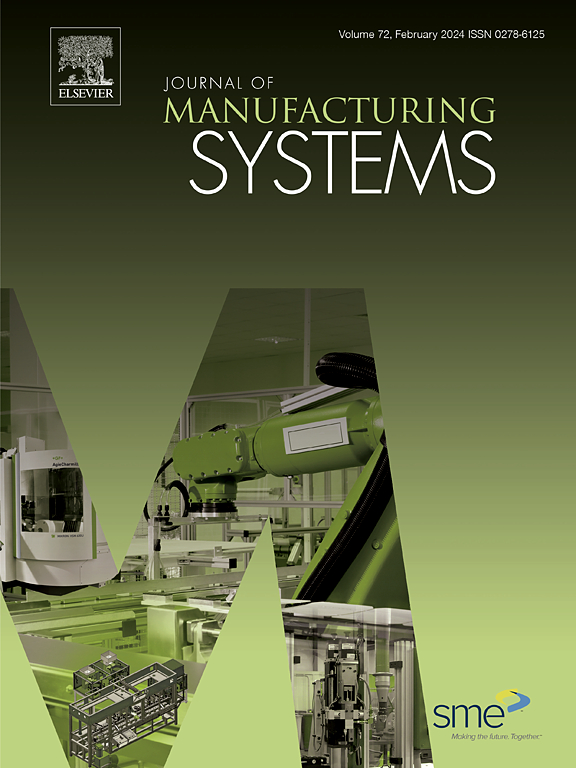Task allocation and scheduling to enhance human–robot collaboration in production line by synergizing efficiency and fatigue
IF 12.2
1区 工程技术
Q1 ENGINEERING, INDUSTRIAL
引用次数: 0
Abstract
Introducing robots to assist humans in production lines can reduce human fatigue, but efficiency should also not be overlooked. Therefore, task allocation and scheduling, which determine who performs tasks and when they start and finish, should consider both efficiency and fatigue in human–robot collaboration. Efficiency needs to be maximized while fatigue needs to be minimized, necessitating a compromise solution to balance these conflicting objectives. Task allocation guided by multiple objectives is computationally more complex. Furthermore, the production line, with its numerous components and tasks, typically has a larger search space, especially in scenarios involving multiple humans and robots. This complexity makes it challenging for most current human–robot task allocation methods to effectively address such problems. Thus, a new task allocation and scheduling method to balance efficiency and fatigue is proposed in this paper. It reallocates initial sequential human actions to all the humans and robots, obtains locally optimal solutions by multi-heuristics search with efficiency and fatigue synergized, and a fast-converging greedy search is then employed to refine these locally optimal solutions to approach the global optimum. What is more, the proposed method was applied to a laboratory-constructed production line and extended to more complex scenarios involving four different setups, as well as the scalability experiment, demonstrating superior task allocation and scheduling capabilities in balancing the efficiency and fatigue of complex scenarios.
任务分配和调度,通过协同效率和疲劳来增强生产线上的人机协作
引入机器人在生产线上协助人类可以减少人类的疲劳,但效率也不应被忽视。因此,任务分配和调度决定了谁执行任务以及何时开始和完成任务,应该同时考虑人机协作的效率和疲劳。效率需要最大化,而疲劳需要最小化,需要一个折衷的解决方案来平衡这些相互冲突的目标。多目标指导下的任务分配在计算上比较复杂。此外,生产线有许多组件和任务,通常具有更大的搜索空间,特别是在涉及多人和机器人的场景中。这种复杂性使得目前大多数人机任务分配方法难以有效地解决这类问题。为此,本文提出了一种平衡效率与疲劳的任务分配与调度方法。该算法将初始顺序人类动作重新分配给所有人和机器人,通过效率和疲劳协同的多启发式搜索获得局部最优解,然后使用快速收敛的贪婪搜索对这些局部最优解进行细化,使其接近全局最优。此外,将该方法应用于实验室构建的生产线,并扩展到涉及四种不同设置的更复杂场景,以及可扩展性实验,证明了在平衡复杂场景的效率和疲劳方面具有优越的任务分配和调度能力。
本文章由计算机程序翻译,如有差异,请以英文原文为准。
求助全文
约1分钟内获得全文
求助全文
来源期刊

Journal of Manufacturing Systems
工程技术-工程:工业
CiteScore
23.30
自引率
13.20%
发文量
216
审稿时长
25 days
期刊介绍:
The Journal of Manufacturing Systems is dedicated to showcasing cutting-edge fundamental and applied research in manufacturing at the systems level. Encompassing products, equipment, people, information, control, and support functions, manufacturing systems play a pivotal role in the economical and competitive development, production, delivery, and total lifecycle of products, meeting market and societal needs.
With a commitment to publishing archival scholarly literature, the journal strives to advance the state of the art in manufacturing systems and foster innovation in crafting efficient, robust, and sustainable manufacturing systems. The focus extends from equipment-level considerations to the broader scope of the extended enterprise. The Journal welcomes research addressing challenges across various scales, including nano, micro, and macro-scale manufacturing, and spanning diverse sectors such as aerospace, automotive, energy, and medical device manufacturing.
 求助内容:
求助内容: 应助结果提醒方式:
应助结果提醒方式:


